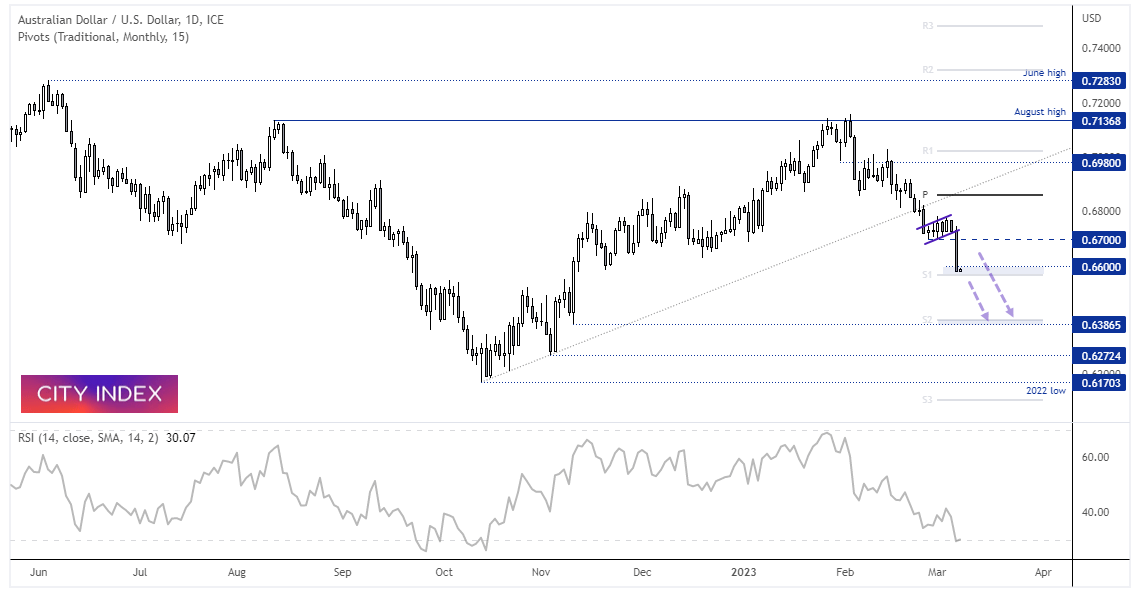
Summary of RBA Governor Lowe’s speech on 8th March
- We are seeking to bring inflation down in a timely way while keeping the economy on an even keel
- …we do need to be prepared for other outcomes as well, including a sharper rise in unemployment
- the monthly CPI indicator for January… provided support to the idea that headline inflation has also peaked in Australia
- we will be looking for further evidence of a deceleration in goods price inflation over the months ahead
- Rents are also rising rapidly
- Overall, we expect that inflation will trend lower this year and next, but there is still uncertainty about the exact path
- Inflation is still too high and it will be some time yet before we are back within the 2–3 per cent target range
- …business surveys continue to report that trading conditions are above average
- …we expect a period of subdued consumption growth, especially in per capita terms
- [Wage] data suggest that the risk of a prices-wages spiral remains low
- …the Board is monitoring the data very carefully month to month. It has the flexibility to respond as needed
- …we are closer to the point where it will be appropriate to pause interest rate increases
On the back of a 25bp hawkish hike, with hypothesized the potential for the RBA to be nearing a pause. Less than 24 hours later, Governor Lowe comes right out and says it.
Speaking at the annual Financial Review Summit with a speech titled “Inflation and Recent Economic Data”, he wrapped up by saying “we are closer to the point where it will be appropriate to pause interest rate increases”.
On one hand we could treat this with some suspicion, as Lowe threw us off the scent in November by speaking of a pause yet RBA statements remained hawkish. But this time around we can be more confident that RBA members are on the same page as Governor Lowe, as the statement tipped us off of a potential pause ahead of Lowe’s comments today.
One more and done?
So is it one more hike and done for the RBA? Possibly, although it seems clear that the RBA are not yet sure of this either, and incoming data will directly impact their decision at their next meeting on April 4th. If we see inflation come in slightly softer (ideally below 7%) and employment data holds it ground, a 25bp in April followed by a pause seems plausible. To counter that, a higher CPI number could wreak havoc for that outcome, especially if accompanied by rising unemployment and soft employment growth. And that could quash any hopes of a pause, keep calls of a 4.1% terminal rate alive and perhaps even see some calls for a 50bp hike. So on that front, incoming data really is our guide as to what to expect at their April meeting, and the RBA will do what the data tells it to.
Upcoming data of interest for the RBA’s April meeting (times in AEDT)
- March 14th 11:30 – Household spending
- March 16th 11:30 – Employment
- March 28th 11:30 – Retail trade
- March 29th 11:30 – Monthly consumer price index
AUD/USD daily chart:

It was the Aussie’s second most bearish day this year, thanks to the combination of (very hawkish) comments from Fed Chair Jerome Powell, and a dovish RBA hike. Fed fund futures now imply a 70.5% chance of a 50bp Fed hike in March (31.4% the day prior) and a terminal rate of 5.75% (5.5% the day prior). When you consider that current calls for the RBA’s terminal rate are between 3.85% and 4.1%, it’s not hard to see why the Aussie suffered yesterday.
The Aussie reached out target around 66c much sooner than we expected. It has found support around the monthly S1 pivot and 66 handle, so perhaps there’s some wriggle room for a little mean reversion (but note that lack of bullish interest today so far). The bias remains bearish below 67, and we be keen to fade into minor rebounds beneath that level in anticipation for a move down to the monthly S1 pivot / 0.6400.
The RSI is nearing oversold, but confirming the leg lower. Besides, RSI has to be oversold during a bearish move, and we’ve not yet seen a bullish divergence form on the daily, 4-hor or 1-hour chart, so price action remain king.
-- Written by Matt Simpson
Follow Matt on Twitter @cLeverEdge
How to trade with City Index
You can trade with City Index by following these four easy steps:
-
Open an account, or log in if you’re already a customer
• Open an account in the UK
• Open an account in Australia
• Open an account in Singapore
- Search for the market you want to trade in our award-winning platform
- Choose your position and size, and your stop and limit levels
- Place the trade










